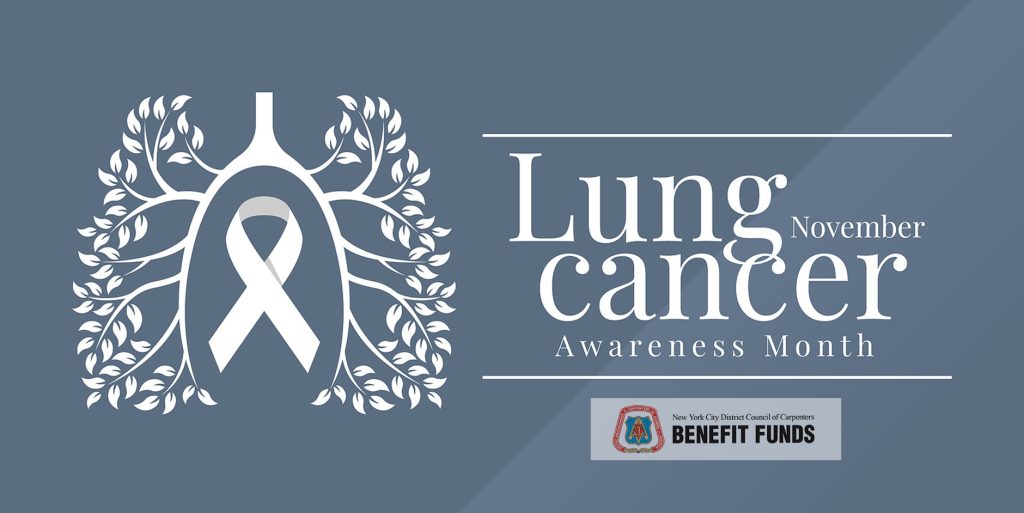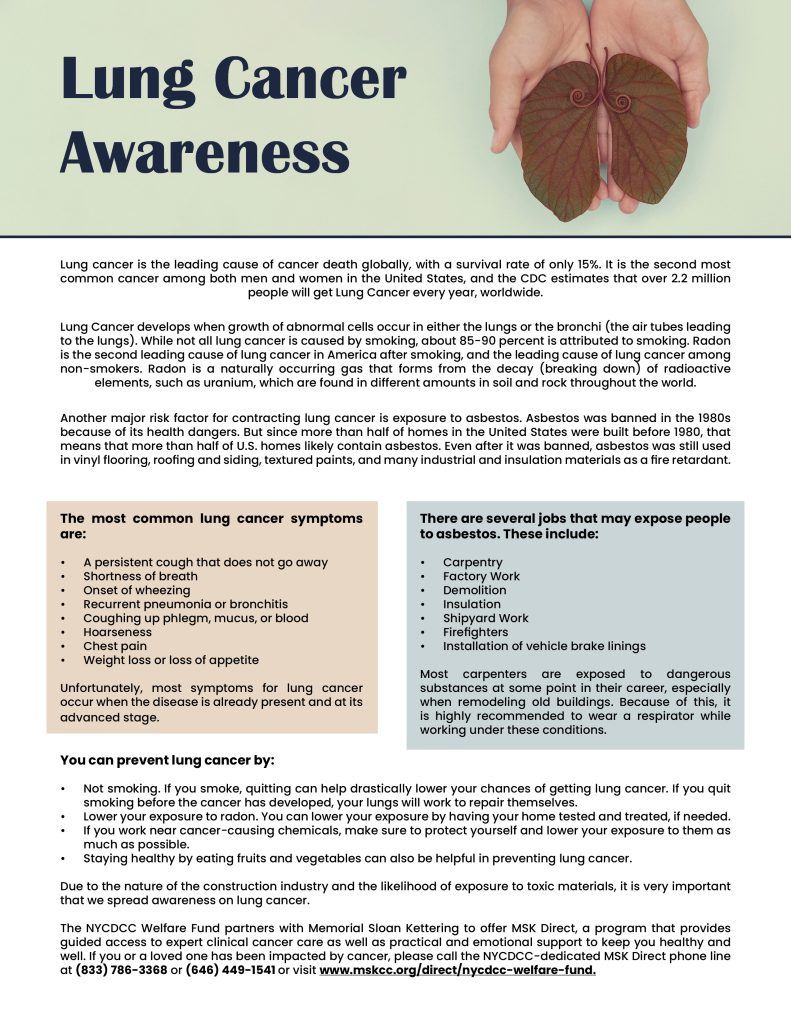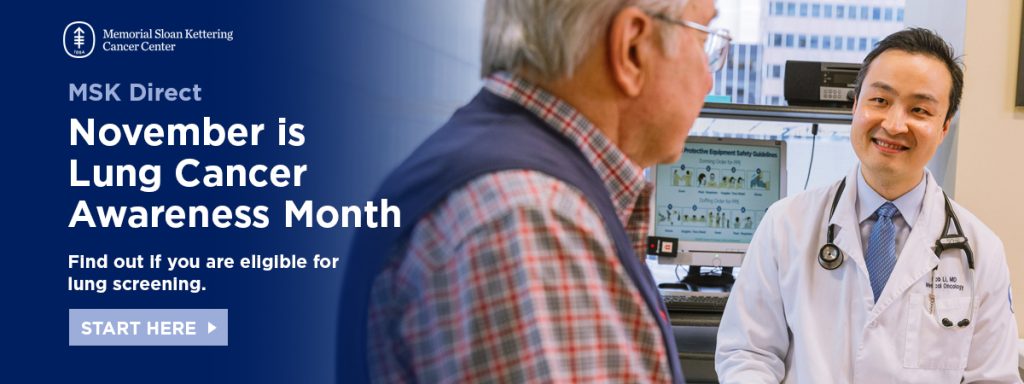November is Lung Cancer Awareness Month
November is Lung Cancer Awareness Month
November 1, 2021

November is officially recognized as Lung Cancer Awareness Month. Lung cancer is the leading cause of cancer death globally, with a survival rate of only 15%. It is the second most common cancer among both men and women in the United States, and the CDC estimates that over 2.2 million people will get Lung Cancer every year, worldwide.1
What is lung cancer?
Lung cancer is one of the most commonly diagnosed cancers. It develops when growth of abnormal cells occur in either the lungs or the bronchi (the air tubes leading to the lungs). While not all lung cancer is caused by smoking, about 85-90 percent is attributed to smoking. Radon is the second leading cause of lung cancer in America after smoking, and the leading cause of lung cancer among non-smokers.2 Radon is a naturally occurring gas that forms from the decay (breaking down) of radioactive elements, such as uranium, which are found in different amounts in soil and rock throughout the world.3
Radon gas given off by soil or rock can enter buildings through cracks in floors or walls; construction joints; or gaps in foundations around pipes, wires, or pumps. Radon levels are usually highest in the basement or crawl space. This level is closest to the soil or rock that is the source of the radon. Therefore, people who spend much of their time in basement rooms at home or at work have a greater risk for being exposed. Your chances of getting lung cancer from radon depend mostly on the level of radon in your home, the amount of time you spend in your home, and whether or not you’re a smoker.4
Another major risk factor for contracting lung cancer is exposure to asbestos. Asbestos was banned in the 1980s because of its health dangers. But since more than half of homes in the United States were built before 1980, that means that more than half of U.S. homes likely contain asbestos.5 Even after it was banned, asbestos was still used in vinyl flooring, roofing and siding, textured paints, and many industrial and insulation materials as a fire retardant.5
Many people do not realize that they came in contact with asbestos. It can happen while working in an attic installing insulation, or by moving the insulation around during repairs or renovations. Asbestos-related lung cancer may not be diagnosed until 15 to 35 years after exposure.5
There are several jobs that may expose people to asbestos. These include:
- Carpentry
- Factory Work
- Demolition
- Insulation
- Shipyard Work
- Firefighters
- Installation of vehicle brake linings
Most construction carpenters are exposed to dangerous substances at some point in their career, especially when remodeling old buildings. Because of this, it is highly recommended to wear a respirator while working under these conditions. Face masks are just not enough, especially in areas that may be highly toxic.6
The most common lung cancer symptoms are:
- A persistent cough that does not go away
- Shortness of breath
- Onset of wheezing
- Recurrent pneumonia or bronchitis
- Coughing up phlegm, mucus, or blood
- Hoarseness
- Chest pain
- Weight loss or loss of appetite
Unfortunately, most symptoms for lung cancer occur when the disease is already present and at its advanced stage. 7
You can prevent lung cancer by:
- Not smoking. If you smoke, quitting can help drastically lower your chances of getting lung cancer. If you quit smoking before the cancer has developed, your lungs will work to repair themselves.
- Lower your exposure to radon. You can lower your exposure by having your home tested and treated, if needed.
- If you work near cancer-causing chemicals, make sure to protect yourself and lower your exposure to them as much as possible.
- Staying healthy by eating fruits and vegetables can also be helpful in preventing lung cancer.
Due to the nature of the construction industry and the likelihood of exposure to toxic materials, it is very important that we spread awareness on lung cancer.7
The NYCDCC Welfare Fund partners with Memorial Sloan Kettering to offer MSK Direct, a program that provides guided access to expert clinical cancer care as well as practical and emotional support to keep you healthy and well.
If you or a loved one has been impacted by cancer, please call the NYCDCC-dedicated MSK Direct phone line at (833) 786-3368 or (646) 449-1541. NYCDCC members can learn more about lung cancer and screenings by visiting www.mskcc.org/direct/nycdcc-welfare-fund/lung-health.
To Use MSK’s Screening tool for NYCDCC Members, visit www.mskcc.org/direct/nycdcc-welfare-fund/lung-cancer-screening-assessment-tool.

To learn more about lung cancer and ways to prevent it, visit the following links:
- Centers for Disease Control and Prevention. (2018, July 19). How Is Lung Cancer Diagnosed and Treated? Retrieved from https://www.cdc.gov/cancer/lung/basic_info/diagnosis_treatment.htm
- U.S. National Library of Medicine. (2017, October 27). Lung Cancer. Retrieved from https://medlineplus.gov/lungcancer.html
- Brey, C. et al. (2020). Lung cancer related to occupational exposure: an integrative review. Retrieved from https://pubmed.ncbi.nlm.nih.gov/32667426/
- American Cancer Society. (2016, May 16). What Is Lung Cancer? Retrieved from https://www.cancer.org/cancer/lung-cancer/about/what-is.html
- Wolff, H. et al. (2015, January). Asbestos, asbestosis, and cancer, the Helsinki criteria for diagnosis and attribution 2014: Recommendations. Retrieved from https://www.ncbi.nlm.nih.gov/pubmed/25299403
- American Cancer Society. (2015, September 15). Asbestos and Cancer Risk. Retrieved from https://www.cancer.org/cancer/cancer-causes/asbestos.html
- National Cancer Institute. (n.d.). Cancer Stat Facts: Lung and Bronchus Cancer. Retrieved from https://seer.cancer.gov/statfacts/html/lungb.html









